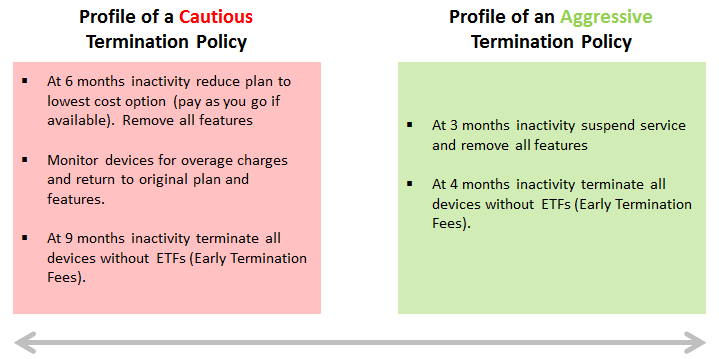Managing Zero Use Devices
Paying When You Shouldn’t
Recently compiled data from a range of client sizes revealed the average number of devices exhibiting at least 3 months of inactivity represents nearly 10% of the total device count. That is a significant number of devices for any size company. Carriers are happy to collect full price on your devices which consume no bandwidth and represent pure profit. When was the last time your carrier presented you with a suggested list of unused devices that should be terminated? Like a subterranean leak that silently adds to your water bill, zero use devices cost you in ways you may not even realize. Let’s look at the 3 steps in an effective management process for unused devices.
Timely Tracking – because the carriers do not issue back credits for prior unused months, asset management is an important step. Most Mobility Managed Service (MMS) solutions will capture and easily identify zero use devices from each monthly invoice, including a running total of continuous months of inactivity. If you are not using an automated solution to uncover wireless cost savings then you would do well to devise a monthly process to identify zero use devices and append that list to a month-to-month tracking capability so you’re aware how long a device has gone without use. The length of inactivity will be a useful parameter in determining actions on devices without identifiable owners.
Owner Identification – once device ownership is identified (not a simple task), the next step is to locate and notify the device owner or their manager to assess the option of terminating or suspending the device. If you have a process to systematically match HR information to each invoice then this step can be easily achieved. An effective wireless cost savings process maintains up-to-date device ownership along with organization and direct supervisor contact information which can facilitate a monthly management notification process to confirm if termination or suspension is appropriate. Denoting emergency devices will save rework in this process. Relying on outdated carrier records by name of device owner will lead to a high percent of unidentified owners.
Handling Unidentifiable Devices – even with an active HR updating process, there will always be a portion for which records are not current (e.g. the owner is no longer with the company or the asset location is unknown). Tracking this information can represent a time-consuming process typically yielding low returns. With this type of tracking, your company will be best served in developing policies to address zero use devices that can be executed on a monthly basis. This becomes a classic case of finding the right risk equation to balance the problem of terminating a device that is expected to be active by its user (a false positive) against the counter problem of monthly waste by not terminating a device that is truly unneeded (a false negative). The cost or pain of acting on a false positive can range from service suddenly failing, to a key executive learning at the wrong moment an infrequently used travel data card has stopped working, to a non-essential employee expressing irritation that their device is no longer working. Risk-averse companies may accept the added cost of paying for inactive devices to avoid a painful termination situation (minimize false positives). On the other hand, cost cutting exercises may lead some companies to endure some threshold of user complaints in order to flush out the wasted spending (minimize false negatives).

Policy Options – shown below is an example of two diverse policy options to balancing false positive and false negative scenarios. Suspending service can reduce cost while providing the device owner time to discover the failing service and preserving the option of keeping the device phone number. Terminating a device for 30 days or longer opens the risk of not getting back the number if the service is reinstated. Depending on your particular circumstances, your optimal wireless cost savings balance may be between these two cases.